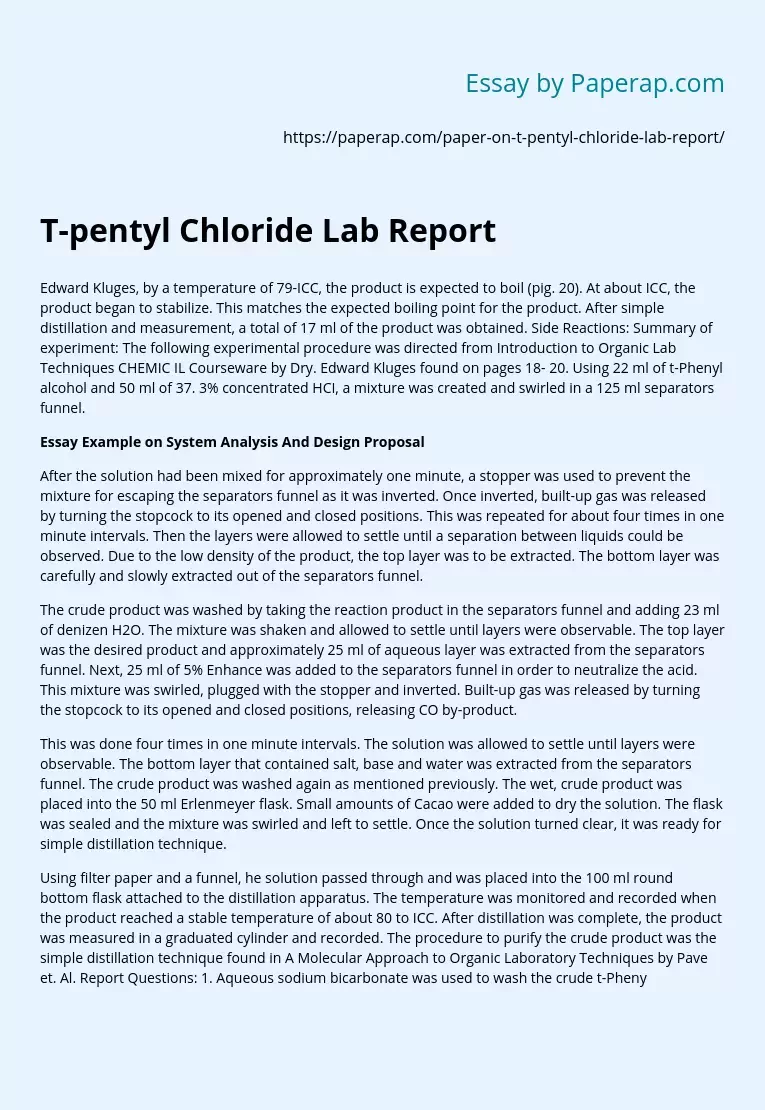Edward Kluges, by a temperature of 79-ICC, the product is expected to boil (pig. 20). At about ICC, the product began to stabilize. This matches the expected boiling point for the product. After simple distillation and measurement, a total of 17 ml of the product was obtained. Side Reactions: Summary of experiment: The following experimental procedure was directed from Introduction to Organic Lab Techniques CHEMIC IL Courseware by Dry. Edward Kluges found on pages 18- 20. Using 22 ml of t-Phenyl alcohol and 50 ml of 37.
3% concentrated HCI, a mixture was created and swirled in a 125 ml separators funnel.
Essay Example on System Analysis And Design Proposal
After the solution had been mixed for approximately one minute, a stopper was used to prevent the mixture for escaping the separators funnel as it was inverted. Once inverted, built-up gas was released by turning the stopcock to its opened and closed positions. This was repeated for about four times in one minute intervals. Then the layers were allowed to settle until a separation between liquids could be observed.
Due to the low density of the product, the top layer was to be extracted. The bottom layer was carefully and slowly extracted out of the separators funnel.
The crude product was washed by taking the reaction product in the separators funnel and adding 23 ml of denizen H2O. The mixture was shaken and allowed to settle until layers were observable. The top layer was the desired product and approximately 25 ml of aqueous layer was extracted from the separators funnel. Next, 25 ml of 5% Enhance was added to the separators funnel in order to neutralize the acid. This mixture was swirled, plugged with the stopper and inverted. Built-up gas was released by turning the stopcock to its opened and closed positions, releasing CO by-product.
This was done four times in one minute intervals. The solution was allowed to settle until layers were observable. The bottom layer that contained salt, base and water was extracted from the separators funnel. The crude product was washed again as mentioned previously. The wet, crude product was placed into the 50 ml Erlenmeyer flask. Small amounts of Cacao were added to dry the solution. The flask was sealed and the mixture was swirled and left to settle. Once the solution turned clear, it was ready for simple distillation technique.
Using filter paper and a funnel, he solution passed through and was placed into the 100 ml round bottom flask attached to the distillation apparatus. The temperature was monitored and recorded when the product reached a stable temperature of about 80 to ICC. After distillation was complete, the product was measured in a graduated cylinder and recorded. The procedure to purify the crude product was the simple distillation technique found in A Molecular Approach to Organic Laboratory Techniques by Pave et. Al. Report Questions: 1. Aqueous sodium bicarbonate was used to wash the crude t-Phenyl chloride. A.
What was the purpose of this wash? The purpose of the wash with the basic bicarbonate was to remove the acidic components of the mixture. This helps facilitate the phase separation needed in order to extract the waste and keep the desired product. B. Why would it be undesirable to wash the crude halide with aqueous sodium hydroxide? Aqueous sodium hydroxide is a very strong base. By using a very strong base, it can cause the reaction to proceed with the E mechanism and gives us undesirable alkaline products. 2. Some 2-methyl-2-butane may be produced in the reaction as a by-product. Give a mechanism for its production.
T-pentyl Chloride Lab Report. (2019, Nov 27). Retrieved from https://paperap.com/paper-on-t-pentyl-chloride-lab-report/

